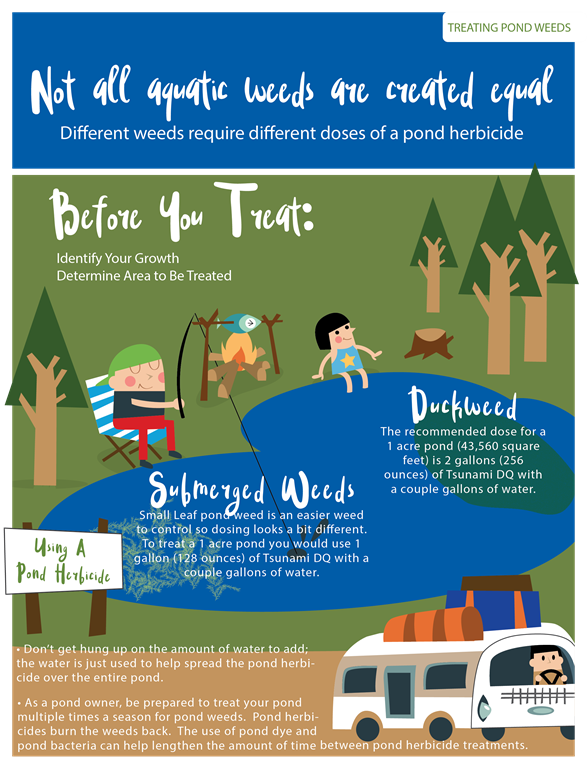Aquatic weeds have been a hot topic this season. We have had more phone calls about aquatic weeds than ever before, so we wanted to address some of the questions and give pond owners some tips to successfully treat their aquatic weeds.
Proper identification is the first step to successfully treating your aquatic weeds. We have a fantastic pond herbicide, Tsunami DQ. Tsunami DQ is labeled to control a large variety of submerged and floating weeds. However, not all aquatic weeds are created equal. Different weeds require different doses of a pond herbicide. Some weeds are more resistant, requiring a higher concentration of pond herbicide to get the job done.
Another consideration is the area covered by the aquatic weeds. If a pond owner is fighting weeds in a beach area their treatment will look different than someone fighting wide spread aquatic weeds.

Ask yourself the following questions:
What aquatic weed do I have?
Use our aquatic plant ID page to help identify your growth.
How large of an area needs treated?
Many pond owners want to know how many ounces of Tsunami DQ per gallon of water they need to be using to spray on their weeds, however, when you treat weeds you should be calculating how many ounces you are spreading over a certain square footage. Herbicide labels can seem large and complicated, but keep in mind the labels are large because the product can control so many different types of weeds. Once you find the area of the label that pertains to your specific problem.
For example, duckweed is one of the most difficult weeds to control and requires the maximum dosage. The recommended dose for a 1 acre pond (43,560 square feet) is 2 gallons (256 ounces) of Tsunami DQ. Don’t get hung up on how much water to add; the water is just used to help spread the pond herbicide over the entire pond. If you use this same model for a ¼ acre pond (10,890 square feet) you would use 64 ounces of Tsunami DQ to treat duckweed. Weeds like duckweed require an environment change to break the growth cycle. To get the growth under control, it is not only recommended to treat with a pond herbicide, but it is imperative that you get the water moving and reduce the nutrients in the pond as well and nutrients entering the pond. Click on the link for more detailed treatment recommendations for pond duckweed.
Small leaf pond weed is an easier weed to control so dosing looks a bit different. To treat a ¼ acre pond (10,890 square feet) you could use 32 ounces of Tsunami DQ to treat small leaf pond weed.
As a pond owner, you should be prepared to treat your pond multiple times in a season for pond weeds. Pond herbicides simply burn the weeds back. The use of pond dye and pond bacteria can help lengthen the amount of time between pond herbicide treatments too.
For additional information on using a pond herbicide to control aquatic weeds contact the experts at Sanco.
